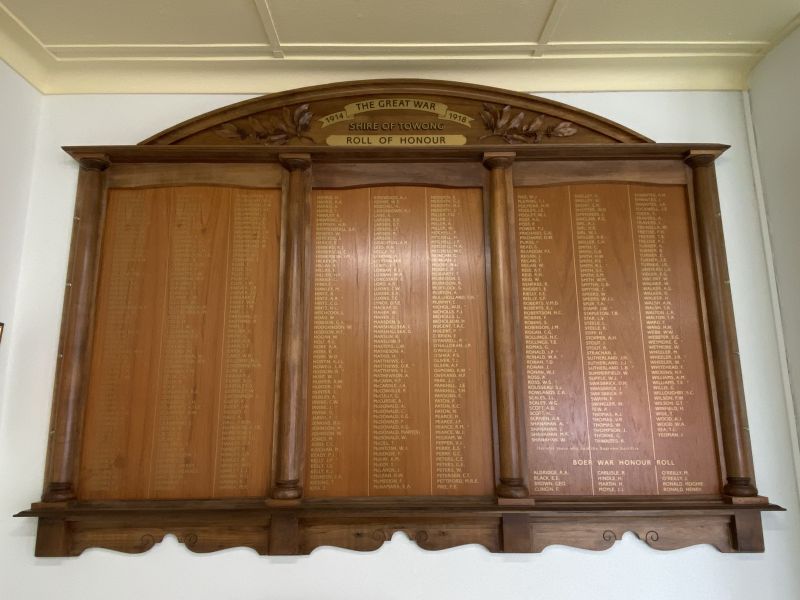Robert William Osmond
Robert was born on the 17th of November 1877 at Tumbarumba, New South Wales. He was one of twelve children to Robert and Joanna (née Loseby). Robert senior's first wife, Mary, died giving birth to twins, both of whom also died.
Robert married Mary Ann Hogan on the 2nd of June 1902 in Croydon, Queensland. Between 1903 and 1907 they had four children, three girls and one boy. The first ten years of their marriage were spent in Queensland. For some of the time Robert worked as a labourer at Iffley Station at Donor’s Hill near Normanton in Queensland. The following year the family moved south to Bethanga, Victoria where Robert gained employment as a labourer.
At the age of 38, Robert enlisted on the 31st of March, 1916, at Cootamundra in country New South Wales. He was allocated the Regimental Number 5649 and initially placed in Company, 1st Battalion, AIF Cootamundra. On the 3rd of June of that year, he was transferred to the 15th Reinforcements for the 18th Infantry Battalion. This unit embarked on HMAT A14 Euripides at Sydney on the 9th of September. Nearly two months later it disembarked at Plymouth in the south of England.
Following two months training on the Wiltshire plains, the 15th Reinforcements embarked on the Princess Henrietta at Folkstone and sailed across the English Channel to join their battalion in France. In early 1917 the battalion was involved in following up the German forces during their retreat to the Hindenburg Line. Their first major battle would take place at the second battle of Bullecourt.
Three days prior to the attack, the battlion moved from their tented camp at Bievillers to billets at Vaulx. Here, final arrangements were made for the up and coming operation against the Hindenburg Line.
Robert’s Red Cross File provides a witness statement explaining what happened to him.
“Killed 3/5/17
Informant describes Osmond as about 5 ft. 7 inches. High, slight, dark, aged about 35/40 – came from the Albury District and married.
Informant states that at Bullecourt on 3/5/17, the 2nd Division, of which his battalion was part, attacked the Germans at about 3 a.m. Osmond went over the parapet with Informant, and he saw him killed at the second line of German trenches. The trenches had been captured by the Australians at about 7 a.m. and they held them against counter attacks all day. Osmond was killed in the afternoon during one of the counter attacks. A fragment of shell hit him in the head, and he was killed instantly.
Osmond was very popular amongst his companions, and was a good soldier.
Informant:-- Private E. Rawson, 5659,
18th Battalion, A.I.F.
No. 4 Australian General Hospital, RANDWICK.”
Twelve months after Robert was killed, Mary wrote to Base Records in Melbourne enquiring about her husband’s deferred pay as it had not been passed on to her. There is no record on the outcome of her letter.
Robert has no known grave. He is remembered at the Australian War Memorial Roll of Honour, the Villers-Bretonneux Memorial (Australian National Memorial), the Bethanga Holy Trinity Church Honour Roll, and the Boer War and WW1 Roll of Honour at Tallangatta, Victoria. For his service he was awarded the British War Medal and the Victory Medal.
However, the war didn’t stop for many families on the 11th of November, 1918. On February the 2nd, 1920, three years after Robert had died, Mary wrote another letter to Base Records in Melbourne.
"Dear Sir,
Your letter to hand also application - but now as I have looked it over and I think it is useless me filling it in as my husband left Australia is Sep16th 1916 and was only 5 months or so fighting in France he was killed on the 3 of May at Bullycome [sic] the poor fellow he is a sad loss to us now and I am hard pressed as my eldest girl is home out of her health and of coars he penson sceased at 16 years and the pension is bareilly enough to live on as I have my four children home now and nothing les coming in living is very expensive now and if my dear husband life had been spared … he would have cept my children if any of them at all time as he was one of the best of husbands pay I may get returned soldiers here told me about the war [unrecognisable word] I will close now. I remain yours truly Mrs A Osmond
Ps Kindly write and let me know if it is any use one filling in the application form and [unrecognisable word]"
Records indicate that Mary continued to live in the Bethanga/Wodonga area and passed away in 1959.
 Stephen Learmonth
Stephen Learmonth